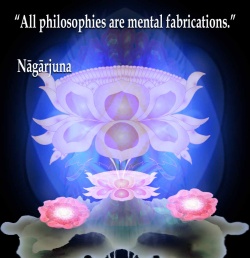Meditation on the Dhamma
Adapted from excerpts from a chapter in The Complete Book of Buddha's Lists -- Explained. David N. Snyder, Ph.D., 2006.
Dhammanupassana is the pali term for meditation on the Dhamma. It is listed as the fourth Foundation of Mindfulness in the Satipatthana Sutta.
The Dhamma is the (more common) Sanskrit word for Dhamma (Pali) which means Truth or Law. The word Dhamma represents the Buddha’s teachings and includes all of the Buddhist concepts, doctrines, and “theory.”
The Dhamma is considered one of the most essential aspects of practice, one of the Triple Gems, the other two being the sangha (community) and the Buddha.
Anyone who is a Buddhist / friend of Buddha’s teachings takes refuge in the Triple Gem. Since the Dhamma is a term for the all-inclusiveness of the Buddha’s teachings, the Buddha emphasized the importance of Dhamma:
“Remain with the Dhamma as an island, the Dhamma as your refuge, without anything else as a refuge.” Samyutta Nikaya 47.13 and also at Digha Nikaya 26
Bhikkhu Bodhi is the American born monk who has translated much of the Pali Canon.
He is a Pali scholar who has done much service to the Dhamma with all of his translations.
He confirms that the translation of the fourth foundation of mindfulness does refer to the Dhamma in this introduction to one of the books of the Samyutta Nikaya: “The word is often rendered mind-objects or mental objects, as if it denoted the sixth external sense base, but this seems to narrow and specific.
More likely Dhamma here signifies all phenomena, which for purposes of insight are grouped into fixed modes of classification determined by the Dhamma itself – the doctrine or teaching – and culminating in the realization of the ultimate Dhamma comprised within the Four Noble Truths.
There are five such schemes: the five hindrances, the five aggregates, the six pairs of internal and external sense bases, the seven factors of enlightenment, and the Four Noble Truths.”
(Bhikkhu Bodhi’s year 2000 translation of the Samyutta Nikaya, pp. 1504-1505)
The Buddha taught in many different forms and on many different subjects, depending upon his audience or the specific individual person he was teaching.
There are 40 different meditation subjects. For example, a devotional person might be given the subject of “Meditation on the Buddha” or some other devotional figure.
A person who has a tendency to hold grudges might meditate on loving-kindness or might meditate on equanimity.
The most common meditation subjects are awareness of breath, contemplation of physical sensations, contemplation of thoughts or emotions, and contemplation on the Dhamma.
All of these four are discussed at length by the Buddha in the Four Foundations of Mindfulness discourse. The first three have been discussed above.
One of the Four Foundations of Mindfulness is the Meditation on the Dhamma.
It is also one of the 40 meditation subjects. A meditation subject is chosen by the meditator or with the assistance of a teacher.
Typically intellectual persons or those who are analytical or like to read are given the meditation subject of Dhamma.
It is a rarely talked about meditation subject.
The reason that some Dhamma teachers do not talk about it is because they do not want beginners to go into this form of meditation without a firm base in the awareness of breath subject first.
If beginners started directly with the Dhamma as the subject, they might believe Buddhist meditation to be nothing but study and then make no progress. Thus, this form of meditation should be done only by advanced meditators.
At a minimum a person should have practiced at least a year in meditation subjects such as physical sensations or awareness of breath and also the meditator should be well versed in at least ten Dhamma books.
Meditation on the Dhamma includes such things as reading a Dhamma book. There are a rare few Dhamma teachers who lacking Insight, knowledge, and wisdom state that reading is “bad” and most certainly not meditation.
Do not let anyone, even a teacher tell you that reading is wrong. Beware of people who say that reading is bad.
What are they afraid of that you might discover? What I am stating here is that reading is meditation and recommended by the Buddha.
In the Four Foundations of Mindfulness the Buddha describes specific analytical contemplations in the part of the discourse on the meditation on the Dhamma, sometimes referred to as “mind-objects” in the Buddhist scriptures.
This includes the analysis of the five aggregates, the seven factors of enlightenment, the hindrances to meditation, and The Four Noble Truths.
In the deep thought or contemplation of various elements of the Dhamma, the meditator may come to some Insights.
The famous monk, Dr. Walpola Rahula, who wrote the classic book, What the Buddha Taught, states that meditation can be on intellectual subjects and that reading a Dhamma book is a form of meditation (meditation on the Dhamma).
This book by Dr. Rahula written in 1959 is still considered one of the best introductory books on Buddhism and is still the recommended book for beginners and others interested in the Buddhist Path.
When the Buddha taught he used many different forms of instruction depending upon whom he was talking to. If the person was analytically inclined then he would use words to encourage that strength in the person’s practice.
Many times an analytical discussion led to Insight and even enlightenment.
In the scriptures of Buddhism there is a story of a whole group of monks who attained enlightenment after discussing Dhamma in an analytical, intellectual way (Khemaka Sutta, Samyutta Nikaya, Sutta Pitaka).
This is not to say that simply reading a Dhamma book will give you the wisdom of enlightenment.
No, not by itself, anyway. Intellectual knowledge and wisdom through inference and analysis is good, but not the insight of enlightenment or an enlightenment experience. However, during the process of contemplation or even the reading of a Dhamma book, an Insight may occur.
This insight is an actual experience by the meditator and not just mere blind acceptance of what is written in the book or mere intellectual knowledge.
How many times have you read something in some magazine or a newspaper or a book and a “light-bulb” appears over your head?
You get some kind of idea about something. Maybe it is an idea of yours on how to “build-a-better-mouse-trap” for example.
Sometimes ideas pop into our head, inventions, better ways of doing something, etc.
This usually happens to us after or during some kind of analysis such as reading a book. In the book we were reading there may even be only a remote similarity to the idea we created. The Insight just appears.
If you have considered yourself a member of a meditation tradition such as Buddhist and sometimes feel guilty because you like to read more than doing the sitting practice; don’t feel guilty.
Sitting meditation practice is very helpful and helps to center our practice around the inner calm of the mind when only awareness and equanimity are present.
But, meditation on the Dhamma is good too.
IT IS one of the meditation subjects of vipassana. To practice meditation on the Dhamma choose one of the subjects listed below.
Contemplate on one of the following elements of the Dhamma:
The Five Hindrances
(The five hindrances are obstacles to meditation, as mentioned in the Four Foundations of Mindfulness.
The five hindrances are sense desire, anger, sloth and torpor, agitation and worry, and extreme skepticism.)
How does one of the hindrances arise and how does it cease? Consider this for all of the hindrances.
The Four Noble Truths
(Life is suffering, the origin of suffering is unreasonable expectation, suffering ceases when unreasonable expectations cease, the way is the Eightfold Middle Path.)
Do the Four Noble Truths agree with analysis and logic?
If so notice if they can be experienced in the analysis of the mind-body.
The Seven Factors of Enlightenment
(mindfulness, investigation, energy, rapture, calm, concentration, equanimity)
Notice when any of the enlightenment factors are present in you.
What is the nature of each of the enlightenment factors?
What type of sensations arise? How does an enlightenment factor arise?
The Five Aggregates
(matter, consciousness, feeling, perception and memory, and mental formations)
What are the aggregates? How does each one relate to the universal characteristics of impermanence, no permanent self, and suffering?
Is there anything permanent in each of the five aggregates?
Are the five aggregates in combination a permanent thing? What is a being?
Dhamma Books
Read a Dhamma book. Read a couple more. If you like to read, go for it. Read several.
Read the original words of the Buddha in the scriptures of Buddhism.
Read the encyclopedic Path of Purification and / or the Path of Freedom, written in the fifth century and the first century respectively.
Dhammanupassana in the Satipatthana Sutta
Five Hindrances:
"There is the case where a monk remains focused on mental qualities in and of themselves with reference to the five hindrances.
And how does a monk remain focused on mental qualities in and of themselves with reference to the five hindrances?
There is the case where, there being sensual desire present within, a monk discerns that 'There is sensual desire present within me.'
Or, there being no sensual desire present within, he discerns that 'There is no sensual desire present within me.'
He discerns how there is the arising of unarisen sensual desire.
And he discerns how there is the abandoning of sensual desire once it has arisen.
And he discerns how there is no further appearance in the future of sensual desire that has been abandoned.
(The same formula is repeated for the remaining hindrances: ill will, sloth and drowsiness, restlessness and anxiety, and uncertainty.)
Five Aggregates:
"Furthermore, the monk remains focused on mental qualities in and of themselves with reference to the five aggregates for sustenance/clinging.
And how does he remain focused on mental qualities in and of themselves with reference to the five aggregates for sustenance/clinging? There is the case where a monk [discerns]:
'Such is form, such its origination, such its disappearance.
Such is feeling... Such is perception...Such are processes...Such is consciousness, such its origination, such its disappearance".
Sixfold Internal Sense Media and External Sense Media:
"Furthermore, the monk remains focused on mental qualities in and of themselves with reference to the sixfold internal and external sense media.
And how does he remain focused on mental qualities in and of themselves with reference to the sixfold internal and external sense media? There is the case where he discerns the eye, he discerns forms, he discerns the fetter that arises dependent on both.
He discerns how there is the arising of an unarisen fetter.
And he discerns how there is the abandoning of a fetter once it has arisen.
And he discerns how there is no further appearance in the future of a fetter that has been abandoned".
(The same formula is repeated for the remaining sense media: ear, nose, tongue, body, and intellect.).
Seven Factors of Awakening:
"Furthermore, the monk remains focused on mental qualities in and of themselves with reference to the seven factors of awakening.
And how does he remain focused on mental qualities in and of themselves with reference to the seven factors of awakening?
There is the case where, there being mindfulness as a factor of awakening present within, he discerns that 'Mindfulness as a factor of awakening is present within me.'
Or, there being no mindfulness as a factor of awakening present within, he discerns that 'Mindfulness as a factor of awakening is not present within me.'
He discerns how there is the arising of unarisen mindfulness as a factor of awakening. And he discerns how there is the culmination of the development of mindfulness as a factor of awakening once it has arisen".
(The same formula is repeated for the remaining factors of awakening: analysis of qualities, persistence, rapture, serenity, concentration, and equanimity.)
from MN 10 Mahāsatipaṭṭhāna Sutta, Ven. Thanissaro, trans.
Source
http://www.dhammawiki.com/index.php?title=Meditation_on_the_Dhamma












